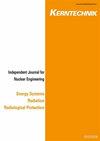基于人工神经网络的翅片管内换热器纳米流体最佳流速预测
IF 0.4
4区 工程技术
Q4 NUCLEAR SCIENCE & TECHNOLOGY
引用次数: 1
摘要
换热器的平均流速对换热器的整体热性能有着重要的影响,因此人们很少考虑换热器的平均流速,因此需要进一步详细的研究。纳米流体的使用对翅片管的设计也有类似的影响。考虑到传热和压降的增加,以及使用翅片和纳米颗粒的成本分析中的不确定性,有必要评估流体的最佳运行速度。相反,在这个问题上没有足够的实验、参数或数值研究。利用机器学习技术对传热应用进行优化是近年来流行的一种方法。本文采用人工智能方法,利用339个数据点,对工艺的重要因素如管数、清洁度因素和总成本作为输出因素进行了估算。研究了雷诺数、导热系数、比热、粘度和翅片总表面效率等输入因素对输出的影响。总管数、清洁度因子和总成本分析的偏差分别为- 0.66%、0.001%和0.12%,这是6种输入溶液的结果。本文章由计算机程序翻译,如有差异,请以英文原文为准。
Prediction of nanofluid flows’ optimum velocity in finned tube-in-tube heat exchangers using artificial neural network
Abstract The average flow velocity in heat exchangers is considered less often and thus needs further and detailed investigation because of its crucial influence on the overall thermal performance of the application. The use of nanofluids has similar influences to finned tube designs. Considering the rise in heat transfer and pressure drop, uncertainties in cost analyses with the uses of fins and nanoparticles, evaluation of optimum operating velocity of the fluids is necessary. On the contrary, there aren’t enough experimental, parametric, or numerical investigations present on this subject. The use of machine learning techniques to heat transfer applications to make optimization becomes popular recently. In this work, important factors of the process as tube number, cleanliness factor, and overall cost as output factors have been estimated by an artificial intelligence method using 339 data points. The influence of input factors of Reynolds number, thermal conductivity, specific heat, viscosity, and total fin surface efficiency on the outputs have been studied. Total tube number, cleanliness factor, and total cost analysis have been determined with deviations of −0.66%, 0.001%, and 0.12% as a result of the solution with 6 inputs, correspondingly.
求助全文
通过发布文献求助,成功后即可免费获取论文全文。
去求助
来源期刊

Kerntechnik
工程技术-核科学技术
CiteScore
0.90
自引率
20.00%
发文量
72
审稿时长
6-12 weeks
期刊介绍:
Kerntechnik is an independent journal for nuclear engineering (including design, operation, safety and economics of nuclear power stations, research reactors and simulators), energy systems, radiation (ionizing radiation in industry, medicine and research) and radiological protection (biological effects of ionizing radiation, the system of protection for occupational, medical and public exposures, the assessment of doses, operational protection and safety programs, management of radioactive wastes, decommissioning and regulatory requirements).
 求助内容:
求助内容: 应助结果提醒方式:
应助结果提醒方式:


